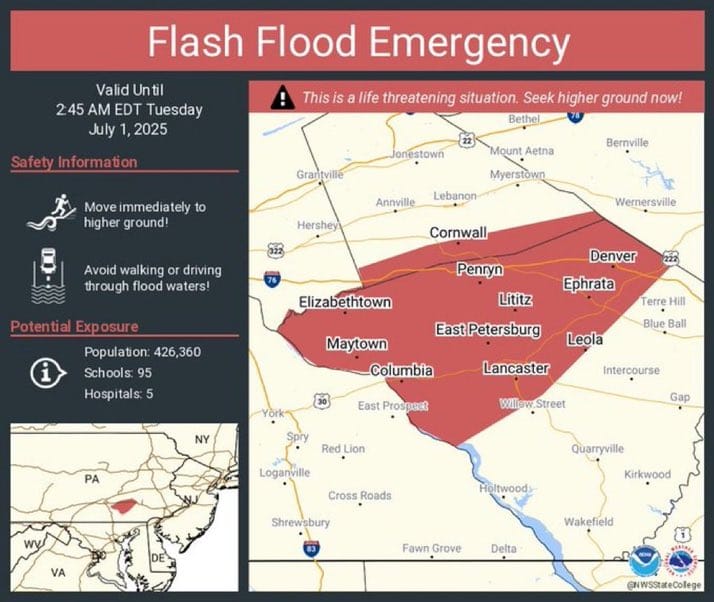As the clock struck 3:34 AM on Tuesday, July 1, 2025, a chilling alert reverberated across Lancaster, Pennsylvania, and its surrounding areas. The National Weather Service issued a rare "Flash Flood Emergency" declaration, marking a life-threatening situation that demanded immediate action. Heavy rainfall, exceeding six inches in less than 24 hours, had transformed the picturesque landscapes of Lancaster County into a watery chaos. For residents, this was more than just another stormy night—it was a wake-up call to the escalating power of nature in an era of changing climates.
The Onset of the Crisis
The emergency declaration came with a stark warning: "This is a life-threatening situation. Seek higher ground now!" The map accompanying the alert painted a grim picture, with a broad swath of red enveloping towns like Lititz, Ephrata, and East Petersburg. The Susquehanna River, a historic waterway threading through the region, swelled dangerously, its banks unable to contain the deluge. By 2:45 AM EDT, the situation had escalated to a point where evacuation orders were issued, urging over 245,000 residents to move to safety.
Local authorities wasted no time. Over 200 emergency responders were deployed, their sirens piercing the early morning darkness as they coordinated evacuations and distributed essential supplies. The scale of the response underscored the severity of the event, with helicopters buzzing overhead to rescue stranded individuals and assess the damage from above. For many, the sight of floodwaters creeping into homes and businesses was a haunting reminder of past disasters, including the devastating 2011 flood that left a $75 million dent in the local economy.
A Community Disrupted
The impact on daily life was immediate and profound. Schools across the affected zone, home to over 22,000 students, shuttered their doors as floodwaters posed a direct threat. Parents scrambled to find safe havens for their children, while teachers and staff joined volunteer efforts to secure school property. Hospitals, too, braced for the worst. Five medical facilities in Lancaster activated emergency protocols, preparing for an influx of patients with injuries ranging from minor cuts to severe trauma caused by the flooding.
Transportation ground to a halt as major highways, including the bustling Route 30, became impassable. Commuters found themselves stranded, their vehicles swallowed by the rising waters. Reports emerged of two cars swept away in nearby Elizabethtown, a sobering testament to the danger of ignoring the "Turn Around, Don’t Drown" advisory. Power outages compounded the crisis, leaving 15,000 homes and businesses in the dark as utility crews worked tirelessly to restore electricity without risking further harm.
The Human and Economic Toll
Beyond the immediate physical dangers, the flood’s ripple effects were felt deeply within the community. Local farmers, whose livelihoods depend on the fertile lands of Lancaster County, faced heartbreaking losses. Fields of corn and soybeans, submerged under more than a foot of water, represented not just crop damage but a threat to the region’s agricultural heritage. The economic fallout promised to be significant, echoing the multimillion-dollar damages of previous floods.
The Red Cross stepped in swiftly, establishing temporary shelters on higher ground. By 10:36 AM WIB—equivalent to 11:36 PM EDT on July 1 in Lancaster—over 300 evacuees had sought refuge, their belongings reduced to what they could carry. Community leaders rallied volunteers to distribute sandbags and support vulnerable populations, including the elderly and those with limited mobility. Social media became a lifeline, with residents sharing real-time updates and photos, enabling emergency services to target the most critical areas with precision.
A Historical Context
Lancaster’s vulnerability to flash floods is not new. The region’s proximity to the Susquehanna River, combined with its rolling terrain, has long made it susceptible to rapid water surges. Historical records recall the catastrophic flooding from Hurricane Diane in 1955, which claimed 113 lives and caused at least $70 million in property damage. More recently, the remnants of Hurricane Agnes in 1972 brought torrential rains that flooded Harrisburg with up to 15 feet of water, a memory still vivid for older generations.
This latest event fits into a broader pattern. Over the past decade, Pennsylvania has seen a 30% increase in flash flood incidents, a trend climate experts attribute to rising temperatures and intensified rainfall. Warmer air holds more moisture, leading to the kind of downpours that overwhelmed Lancaster in the early hours of July 1. Urban development, too, has played a role, with paved surfaces reducing the land’s natural ability to absorb water and increasing runoff into rivers and streams.
#### The Role of Nature and Human Influence
Environmental groups have pointed to deforestation in the Susquehanna watershed as a contributing factor. The loss of trees and vegetation, which once acted as natural sponges, has diminished the region’s capacity to mitigate flooding. This concern has sparked renewed calls for reforestation and sustainable land management practices, though such efforts require time and investment—luxuries the community currently lacks amid the crisis.
The U.S. Army Corps of Engineers joined the response, monitoring nearby dams to prevent potential breaches as water levels continued to rise. Their presence offered a glimmer of hope, but also a stark reminder of the infrastructure challenges posed by increasingly frequent extreme weather. Meteorologists, meanwhile, predicted that the rain would taper off by late afternoon, though the threat of residual flooding lingered, promising days of recovery ahead.
A Regional Concern
The storm system responsible for Lancaster’s plight showed no signs of dissipating quickly. Neighboring states like New Jersey and Maryland were placed on high alert, with officials bracing for similar conditions as the weather front moved eastward. In New York, reports of overnight flooding suggested a regional emergency unfolding in tandem with Lancaster’s struggle. This interconnected threat highlighted the need for coordinated action across state lines, a challenge that emergency management teams were only beginning to address.
Looking Ahead: Resilience and Recovery
As the waters receded, the focus shifted to recovery. The Lancaster County government, having activated its emergency operations center for the first time in 2025, worked to assess the full extent of the damage. Community leaders emphasized the importance of preparedness, urging residents to practice evacuation routes and consider flood insurance—a critical safeguard, given that standard homeowners’ policies often exclude flood damage. Websites like floodsmart.gov were recommended as resources for those seeking to protect their properties moving forward.
The human spirit, however, remained unbroken. Stories of neighbors helping neighbors emerged, with trained individuals providing first aid until professional responders arrived. Volunteers distributed supplies, and local businesses offered free meals to those displaced. This collective resilience offered a beacon of hope amid the devastation, a reminder of the strength found in unity during times of crisis.
The Bigger Picture
The flash flood emergency in Lancaster is more than a local tragedy—it is a microcosm of a global challenge. Scientists warn that climate change is amplifying the frequency and intensity of such events, with urban areas particularly at risk due to their impervious surfaces and dense populations. The 2025 season has already seen similar incidents across the Northeast, prompting calls for long-term strategies to adapt to this new reality.
For Lancaster, the road to recovery will be long. The physical cleanup will take weeks, if not months, while the emotional and economic scars may linger longer. Yet, as the community bands together, there is a shared determination to rebuild stronger and smarter. The lessons learned from this flood—about preparation, community support, and the power of nature—will shape the region’s future, ensuring that when the next storm comes, Lancaster will be better equipped to weather it.
As the sun rises over the flooded landscapes on this Tuesday morning, the people of Lancaster stand at a crossroads. The immediate danger may pass, but the work to secure a safer tomorrow has only just begun. With every sandbag filled, every volunteer mobilized, and every lesson absorbed, the community moves forward—not just to recover, but to thrive in the face of an uncertain climate future.
Flash Flood Emergency Strikes Lancaster, Pennsylvania: A Community Under Water
The National Weather Service issued a rare "Flash Flood Emergency" declaration, marking a life-threatening situation that demanded immediate action.


